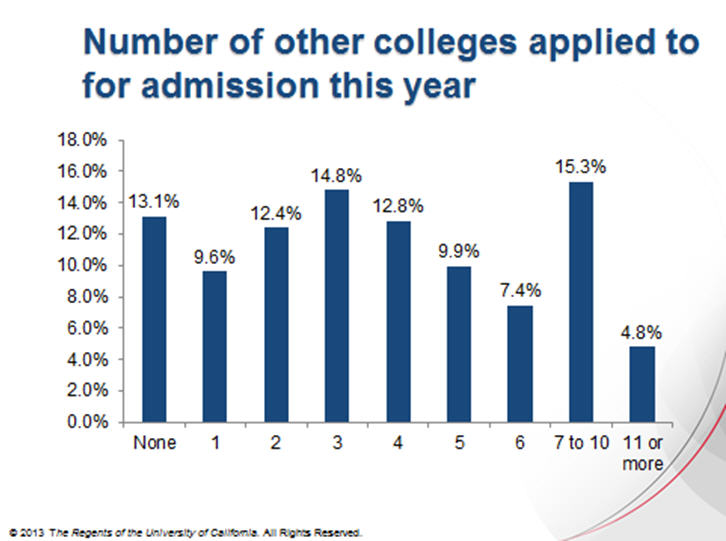enrollment
Turning incomplete college applications into completed ones
My colleague Andrea Gilbert was right on point with her February blog post, “Nine strategies for generating college applications in the student recruitment home stretch.” I want to continue the discussion by examining the next stage in the application process: moving students to the admitted stage. Each year, thousands of students apply to institutions across the country. However, it’s nearly impossible to influence their decisions if they don’t complete the application process. Students’ desires may fluctuate depending on what is going on in their lives, but this underlying fact remains—if they started the application process with your campus, they’re interested.
The 2012 Cooperative Institutional Research Program Freshman Survey found that 64.9 percent of respondents applied to three or more institutions, and an astounding 20.1 percent said they applied to more than seven institutions (see page 24 of the PDF):
The problem is that these students may not always complete the application process. These incomplete applications are a problem for admissions teams, who often spend an inordinate amount of time chasing down pieces needed to complete the application.
Quick strategies for completing incomplete college applications
Here are a number of ideas to snag the missing pieces of applications so your team can focus on forming relationships with students who are the best fit for your institution.
- Contact high school counselors directly to see if they can release documents to the admissions team. In most cases, students may need to provide permission. However, you may be able to get the guidance counselor to reach out to specific students in question.
- If your admissions team has spring high school visits, target your feeder high schools and ask students to bring their missing documents to the visit.
- Send out missing documents postcards to direct students and their families to an online status check. Postcards are ideal because everyone in the family can see what’s missing and might be able to help submit missing items.
- Remind students why your institution could put them at an advantage, whether it’s showcasing a strong biology department, profiling the recipient of a top scholarship, or other compelling benefits.
- Depending on the time of the year, your team may be able to promise a 24- to 48-hour application review once you’ve received a completed application.
- Consider admitting students based on self-reported standardized exam scores. There is strong evidence that students rarely lie about their scores (see this Chronicle of Higher Education article). You can conditionally admit a student and then lift the condition once you’ve received official standardized exam scores. An extra tip—admissions counselors should always include the school’s ACT, SAT, and FAFSA codes in their signature blocks.
- Check the back-end of your online application system regularly to see how many students have started but not completed the application process. Follow-up communication may be all that’s needed to get these students over the hump.
- Have other key members of your campus reach out to encourage application completion. For example, coaches and fine arts faculty can give students a nudge.
- Use Twitter and Facebook to communicate application deadlines and other pertinent information, such as test scores and FAFSA codes.
- Prioritize application completion by tackling your high-performing initial source codes. Applicants whose initial source code comes from a standardized exam or referral are probably stronger sources than those who were solicited.
- Consider extending your deadline if you haven’t generated the required number of admitted students to reach your goals. It might be helpful to announce the extension in this way: “Because of the strong interest of our pool this year, we’ve extended the application deadline to (new date) to accommodate the interest.”
- Use on-campus events during the spring to drive application completion. Tell students, “If you bring a completed application to the open house this week, we’ll review it during your campus visit and notify you of admission prior to your departure.”
- Use online survey tools to communicate with incomplete applicants to determine their interest in your institution.
- Request writing samples, such as a graded paper, if there’s an essay holding up an application.
While this list can be customized to fit your institution’s mission, it might not be right for all organizations. If you’re interested in comparing your student enrollment behavior with other institutions, download our 2012 Recruitment Funnel Benchmarks Report. Remember, you can’t influence students if they aren’t admitted to your institution, so consider all options as you and your team work to move students to the next stage in the recruiting cycle.
Do you have any strategies you would like to share? Please leave them in the comments, or send me an email—I’m always interested to hear what campuses are doing to deal with incomplete applications.

